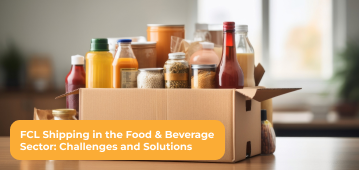Air, Sea, or Ground Freight Shipping What’s Best For You?
What’s the most appropriate form of Freight Shipping?
Is it by air, sea, or ground?
These questions might sound simple to choose from, but it can be an uphill task as most business owners or decision-makers are unaware of the pros and cons of different modes of freight shipment. The traditional answer to the question is to decide depending on the factors like weight, size, or type of cargo you need to transport. But still, you might end up choosing the wrong mode of transportation and paying a higher shipment amount.
But you don’t need to worry. We got you covered.
Let’s understand the nitty-gritty elements of different freight transport types and filter out your business’s best freight shipping mode.
Freight Transport Types
Sea Freight
The largest shareholder of the transported goods globally, sea freight accounts for over 90% of transportation. Cargo or container ships travel across the ocean to reach the destination point. Specialized vessels carry heavy cargo with high volume bulk commodities like animal feed, grains, fertilizers, lumber, salts, equipment, and different products.
Pros
- It is one of the most effective freight shipping forms as the shipment price is calculated per container.
- It can ship vast volumes of cargo that include heavy and large goods.
- The success rate of the arrival is nearly 99.99% which makes it one of the reliable modes of freight shipment.
- It leaves a comparatively small carbon footprint compared to other bulk freight shipment modes, and it is a greener shipment form.
- It can help you deliver goods from one corner of the world to another.
Cons
- The transit time is slower than air freight which takes 10x less time to reach the destination.
- There can be delays at the port due to traffic or other issues that can lead to stuck cargo and no means to unload it.
Air Freight
Both cargo and passenger aircraft are used in air freight shipments to transport goods globally. One of the top time-efficient forms of a freight shipment can help you meet strict deadlines. It’s excellent for fast commodity markets and helps the industry achieve its desired business outcomes with swift deliveries.
Pros
- It is the fastest form of freight forwarding and offers agile air cargo transportation to deliver from one continent to another.
- The range of shipment is excellent as it can reach outstretched places within a limited time.
- The success rate of the air freight shipment is excellent and is one of the reliable modes.
- It can deliver light goods and equipment and small or medium-sized paced products.
Cons
- The most expensive form of freight shipping and the shipment calculation is based on the goods’ actual weight or volumetric weight.
- It cannot ship heavy or large cargo and has a limited shipment capacity.
- If the cargo contains hazardous substances, it can’t be shipped using air freight.
- Aircraft emit over 500gm of CO2 per km per metric ton of freight transportation resulting in a considerable carbon footprint.
Ground Freight
The land freight is suitable for domestic or intra continent freight shipment. Trucks, trains, and heavy transportation ground vehicles are used in the process and can be ideal for businesses with specific requirements that demand ground freight delivery.
It can also be the middle spot between a ship and air freight forwarding as it is inexpensive compared to air freight and reaches places where sea freight can’t reach.
Ground freight is also used once the shipment arrives at the docs or airport from other freight forwarding means.
Pros
- For short distances, ground freight is cost-effective and economical compared to others.
- Ground freight customs clearance is easier than sea and flight as a single document can sometimes allow seamless movement between countries.
- It offers door-to-door services to deliver a quality customer experience for the customer.
- Rail freight is highly environment friendly and minimizes carbon emissions compared to road freight.
- Trains are not hindered in any traffic, and the transit and delivery schedules are usually on time.
Cons
- Transportation can hinder in case of inclement weather or traffic (with trucks)
- The shipment capacity depends on the size of the vehicle.
These were the significant benefits and drawbacks of different types of freight forwarding. You can tailor your business requirements based on these insights and finalize one for your business.
Choose Your Route
Relying on one route for transportation is not the ideal decision to make. As the customer demands evolve, you might need different freight shipment types at different times. It can become a headache for you to manage different transportation processes and, at the same time, focus on your business’s core activities.
You can associate with the leading freight forwarders to simplify your transportation and delivery process to save you from troubles.
Like





Comments